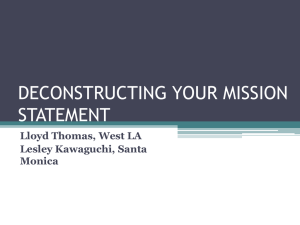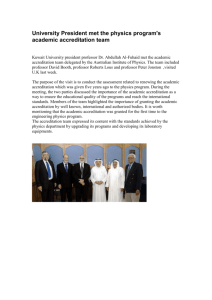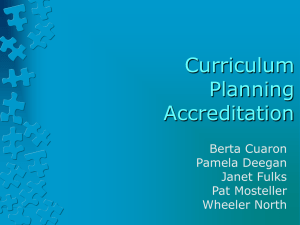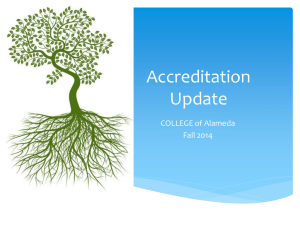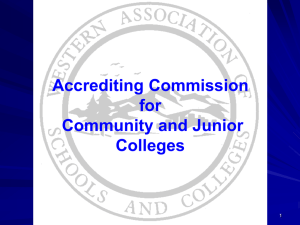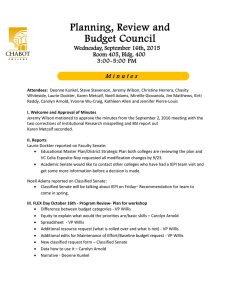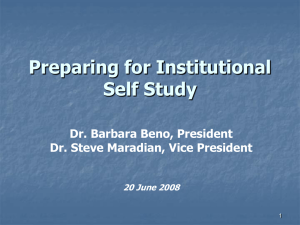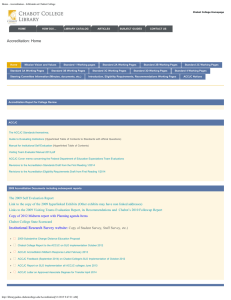Mission College Accreditation Workgroups
advertisement
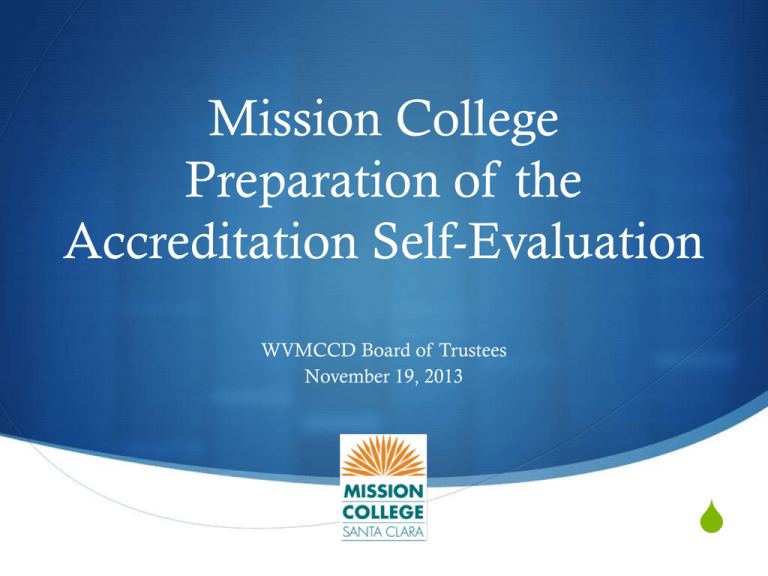
Mission College Preparation of the Accreditation Self-Evaluation WVMCCD Board of Trustees November 19, 2013 S Overview and Purpose S What is the purpose of Accreditation? S An effective institution ensures that its resources and processes support student learning, continuously assesses that learning, and pursues institutional excellence and improvement. S Why do we do a “Self-Evaluation?” S How often? S 6 Year Cycle Accreditation Standards S Standards in Brief S I: Institutional Mission and Effectiveness S II: Student Learning Programs and Services S III: Resources (Human, Physical, Fiscal, Technology) S IV: Leadership and Governance Self Evaluation Document Preparation Structure Accreditation Oversight Committee GAP serves as the oversight committee Accreditation Steering Committee Includes Faculty Liaison, Accreditation Officer, Document Editor, and Researcher 4 Standards Writing Teams Focused teams for collecting evidence and writing; Teams Include Faculty, Classified Staff, & Administrators Timeline of Preparation S Fall 2012–Standards Teams completion of templates and initial identification of evidence S Spring 2013— Initial review, additional evidence gathering, begin pulling into one comprehensive draft S Summer 2013—Identification of gaps; continue editing S Fall 2013—Fill in gaps; targeted groups review for accuracy and thoroughness Process Kickoff S Standards Teams identified Spring/Summer 2012 S Full Teams Kickoff event August, 2012 S Training on standards and rubrics S Process of discovery and gathering evidence S Collaboration on ANGEL learning management S Resource binders S S S Reference materials Sample templates Potential locations for evidence Team Chairs Recognition I: Institutional Mission and Effectiveness: Kathy Henderson & Zita Melton with Daniel Peck II: Student Learning Programs and Services: Sarah Sullivan & Sarah Randle; Theresa Lawhead & Lucia Moreno; Carol Brockmeier & John Spencer with Tim Karas, Penny Johnson, Rita Grogan III: Resources (Human, Physical, Fiscal, Technology): Cathy Cox & Kena Rogers; Pat Hudak & Greg Shaw; Clement Lam & My Loi with Rick Bennett, Mina Jahan IV: Leadership and Governance: Dianne Dorian &Susan Monahan with Laurel Jones, Penny Johnson Participatory Involvement S Structure of the Standards Teams S Co-chairs of Faculty and Classified Staff S Members include faculty, classified staff, administrators, & students S Draft made available online in late Spring S Ability to post feedback S Recurring updates and reminders for feedback to college S Targeted visits to participatory and operational groups S Academic Senate, Classified Senate, GAP, Division Council, Student Services Council, Counseling Department meeting, Curriculum Cmt, Institutional Effectiveness Cmt, Technology Cmt, and more Online Document S https://sites.google.com/site/missionaccreditation/ Addressing Action Items S Through this Self Evaluation, the College has identified “Actionable Improvement Plans” S The college is already working to address identified areas for improvement S Goal to address areas prior to March Site Visit S Two primary areas of emphasis S Distance Learning (infrastructure, training, monitoring) S Student Learning Outcomes (documentation of assessment, linkage to program and institutional outcomes) Final Steps S Remaining Stages of Preparing Document S Final formatting and editing S Insertion of final pieces of evidence S Final Draft review by primary participatory groups S Already given to GAP, Academic Senate, and Classified Senate S Final formatted version available by start of December S Mailed to ACCJC in January Site Visit Preparation S Preparing Access to Evidence S Posting all evidence online and creating thumb drives for visiting team S Messaging to College Campus S Creating document summaries and brief mini-videos to raise awareness prior to the visit S Preparation of team room and meeting schedule S Site Visit in March 2014 Post Site Visit S ACCJC likely will take action in June S The college will continue to address identified areas for action Discussion


